How To Catch Spanish & King Mackerel Like A Pro
- By: Joseph Simonds
- on
- Found In: Fishing Tips, Offshore Fishing, Spanish Mackerel
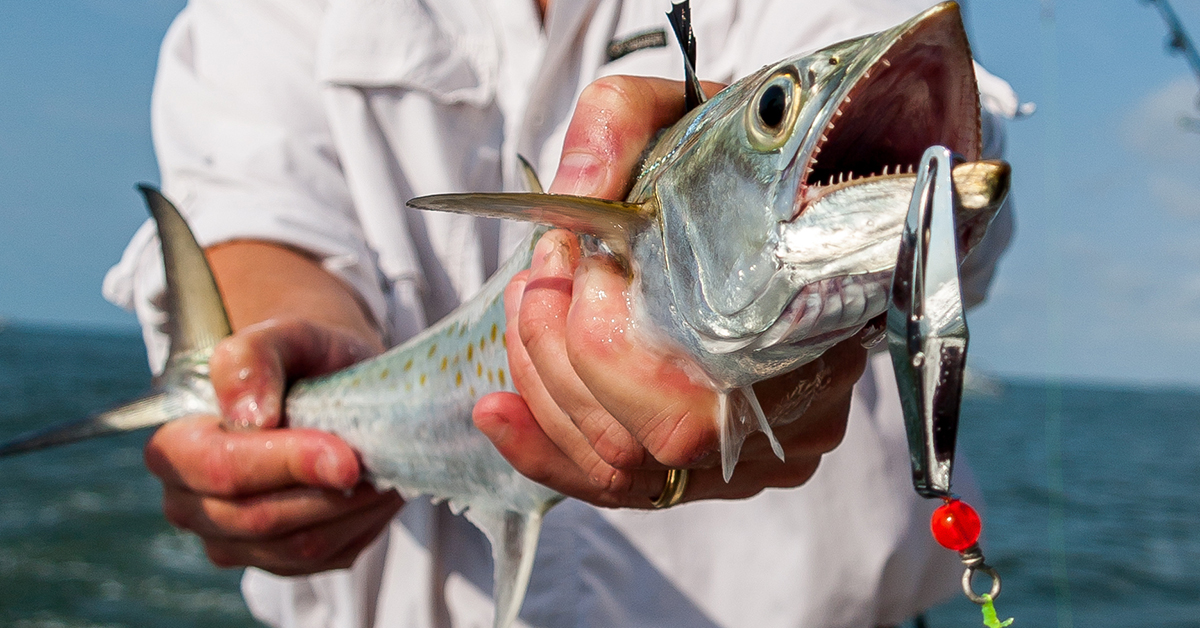
It’s mackerel time!
Spanish mackerel and king mackerel are two of the most fun fish you can catch on light tackle.
Their drag peeling runs are a blast and if you get into a school of Spanish mackerel it can be nonstop action!
The other day I was surfing YouTube looking for some tips on catching kingfish and I came across this amazing seminar by Captain Van Hubbard on Bill Miller’s YouTube channel.
Now, to say Capt. Van Hubbard is a good fisherman would be quite the understatement.
Here are some of his credentials:
- Won the William R. Mote Sport Fishing Guide of the Year in 1999
- Won the Frank Philpott Conservation Award 2001, from Florida Outdoor Writers Association
- He’s actively involved in conservation and works with Mote Marine Laboratory, Florida Marine Research Institute, Florida Fish & Wildlife Conservation Commission, and other conservation and research groups
- He’s been guiding in the Venice, Charlotte Harbor, and Boca Grande areas for the past 40+ years
This seminar was packed with some great tips for Spanish and king mackerel fishing, but at 43 minutes long, it’s quite the investment if you want to watch it!
So I did the work for you and broke it down into the major points of how to catch mackerel below.
You can also watch the video at the bottom of this post.
Enjoy!
The Best Leader For Spanish & King Mackerel
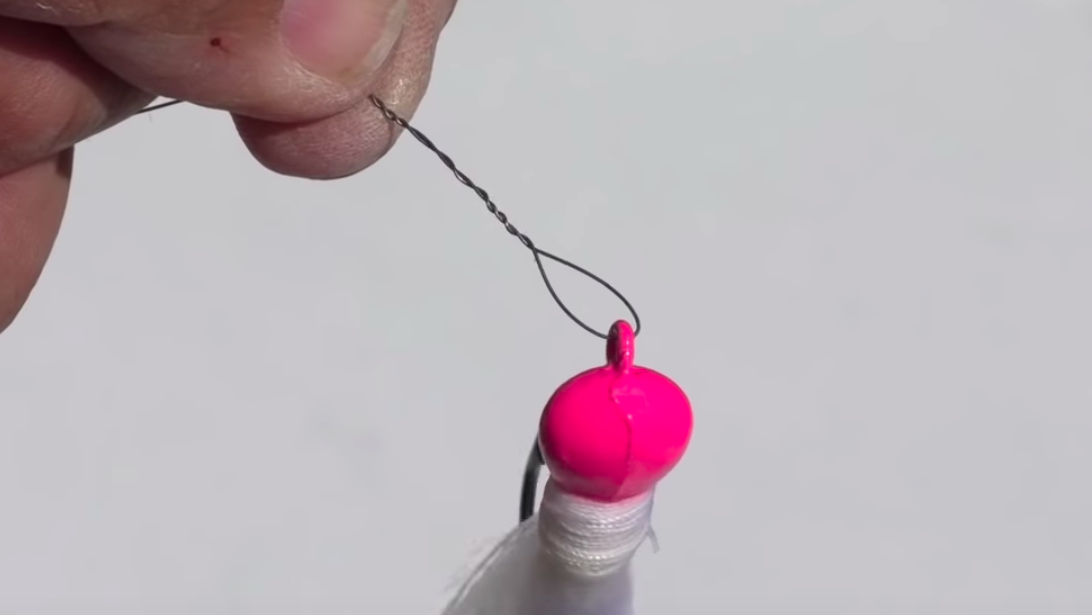
Capt. Hubbard spent most of his time talking about terminal tackle here, which is especially important for mackerel for two reasons:
- They have sharp teeth and can easily shred your leader
- They have great eyesight, so they can easily see your leader
For his main line, he’s usually using 15-20 lb braid, but for the leader, that varies much more.
How clear is the water?
Is he targeting Spanish mackerel or kings?
How big are they?
Because of their great eyesight, Capt. Hubbard prefers to use the lightest leader possible.
You can’t catch any fish if you don’t get any bites, and the only thing worse than getting broken off by a mackerel is not hooking into one at all.
He typically uses 30-40 lb fluorocarbon leader for Spanish mackerel, although he will go with something heavier if there are kings around.
If he’s targeting kings, he normally uses #3 wire leader.
That being said, if he’s not getting any bites, but knows there are hungry kings around, he may forgo the wire leader in favor of a fluorocarbon leader to convince them to bite.
And here’s a pro tip for using fluorocarbon: if you can see abrasions or knicks in the line, so can the fish.
Make sure to change your leader if you do have abrasions or knicks.
As for the hooks, he does recommend 3x or 4x strong hooks if he’s targeting big kingfish.
To see the best knot for when you’re using wire leader, check out the video below.
How To Tie The Haywire Twist [VIDEO]
This knot is perfect for tying wire leader to hooks or jigheads.
Chumming For Kingfish & Spanish Mackerel
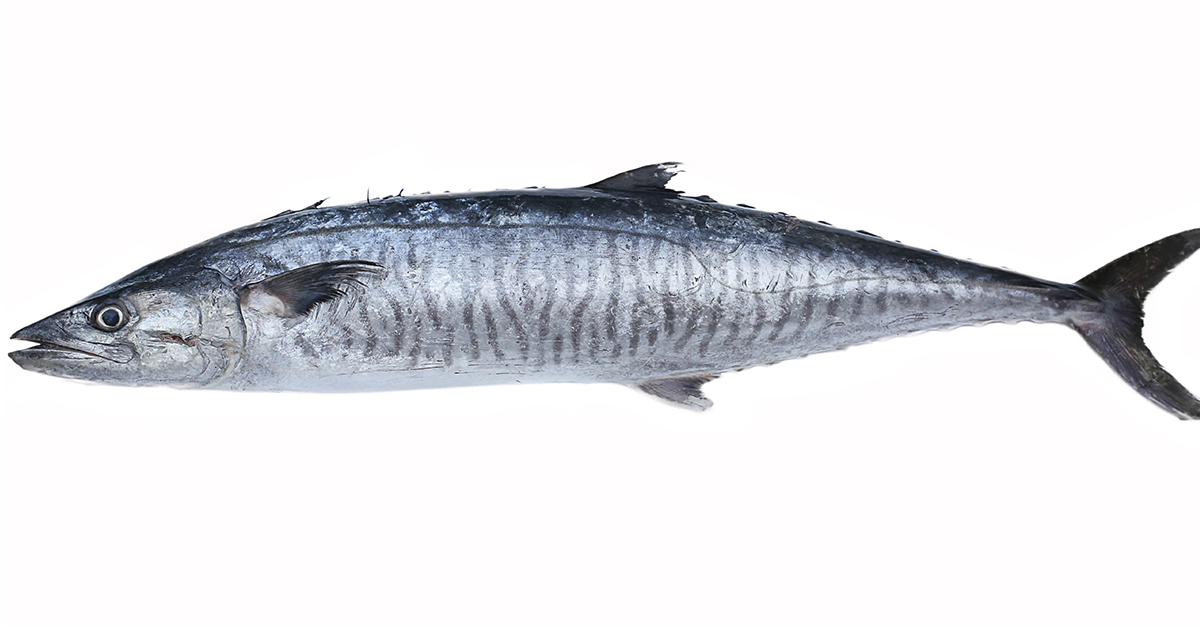
There are some things in fishing that you want to be stingy with, but chumming while trying to attract kingfish is not one of them.
You want to be generous with the chum, so if you’re using a mesh bag, make sure that the holes are big enough to let the chum out fast.
Capt. Hubbard’s favorite chum is the Menhaden Tournament Chum, although he’s had success with others as well.
And if someone is cutting up sardines and throwing them off the back of the boat, make sure that they’re only throwing out one chunk at a time, and not a handful of chunks.
Here’s why: if you start throwing out handfuls of sardine chunks, the fish won’t follow the boat…
Instead, they’ll stop and fill themselves up on the handful of chunks you just threw out!
And although he loves chumming for kingfish, there is a time when he won’t chum: when the sharks are bad.
Sharks have better sniffers than mackerel, so if there are sharks around, you can bet they’ll find your chum slick, and the taxman would love to make an appearance.
Finally, one last tip about chumming…
If you’re slow trolling and chumming, make sure to be trolling in circles.
This will be much more effective than if you’re just going in a straight line and you never retrace your chum slick.
Which leads us to our next point…
Trolling For Mackerel
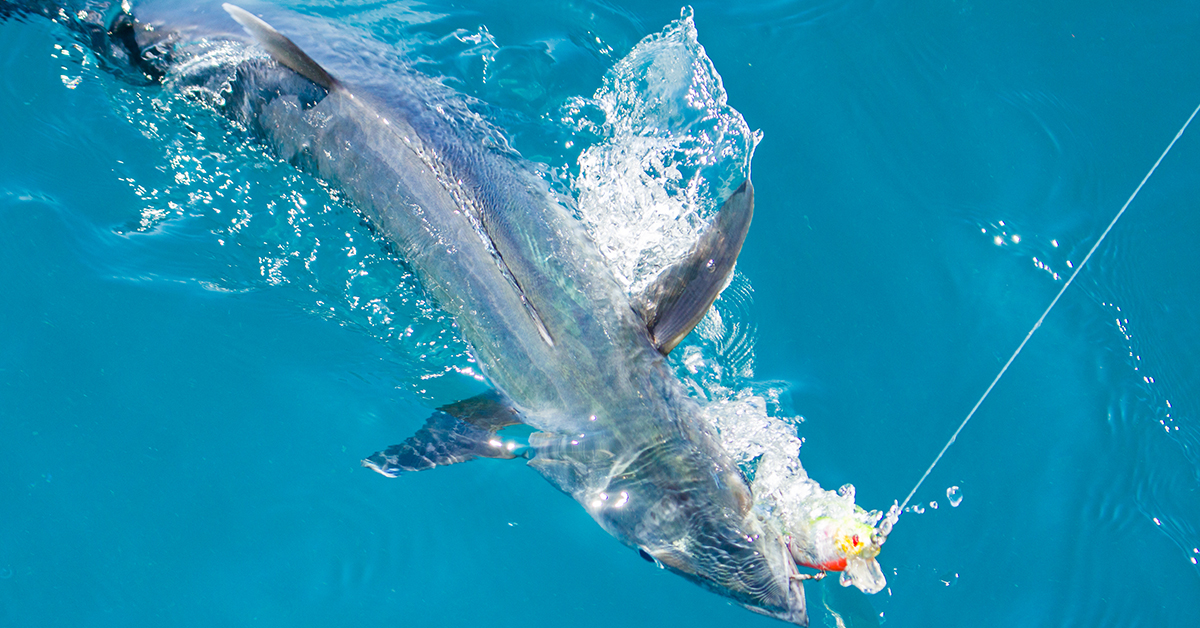
Capt. Hubbard loves trolling for mackerel.
Here’s why:
- If you catch a big fish you can follow it faster (even faster than if you had a breakaway anchor)
- When you’re trolling your line is usually tight, unlike if you’re anchored up and have a live bait floating out there
- If a kingfish comes up to hit a big bait that is still, he’ll often circle around it first, so if your line is lying out there he might saw it off and steal your bait (this is why Capt. Hubbard recommends kite fishing if you’re anchored up)
His goal with trolling is to just keep his line tight, so he’s usually trolling slowly with his motor in idle.
The only time he’ll go faster than that is if he’s going with the current, or the wind is particularly strong and it’s tough to keep his line tight.
And interestingly enough, Capt. Hubbard often catches his biggest fish with big baits right behind the boat.
When he’s fishing big baits behind the boat, he’s able to get away with heaver leader because white water from the prop wash hides it.
The Best Bait & Lures For Spanish & King Mackerel
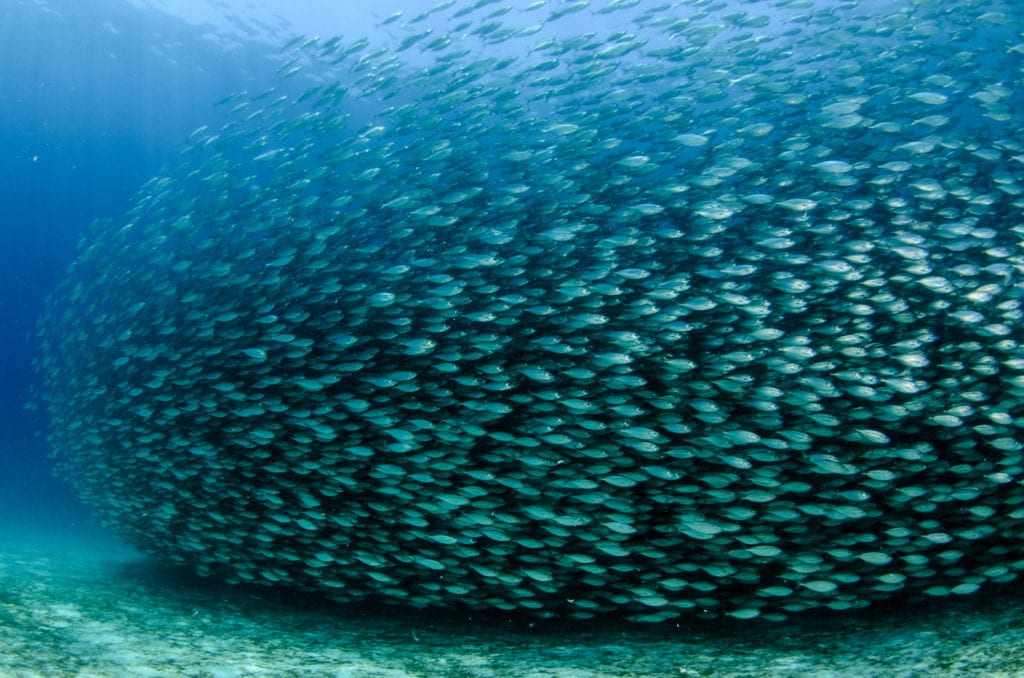
So you’ve got the right equipment, you’re chumming and trolling…now what are you going to use to get them to actually bite?
Capt. Hubbard catches fish with both live bait and artificial lures.
Some of his favorite artificial lures include:
- Spoons
- Big lipped diving lures
And like anytime using artificial lures, you want to match the hatch.
Make sure that your lures are about the same size as the baitfish that the mackerel are currently eating.
Good live bait options include:
- Pilchards
- Threadfin Herring
- Blue runners
- Mullet
- Menhaden
And when using live bait, here are some pro tips that Capt. Hubbard shared:
- Put the stinger hooks in the fish (this will make sure the hooks aren’t awkwardly hanging down when he’s slow trolling, and will keep them from sticking him!)
- When handling bait, always use wet hands. If you use dry hands when you catch or hook your bait, you’ll be able to see black spots where your hands touched them (and the fish can see them too).
- Use circle hooks because they can often hook a fish in the side of the mouth where there are fewer teeth. Another tip here is to always steer the fish towards the side that the hook is in. If the line crosses the fish’s mouth and teeth, it’s likely to get cut off.
- If you can pen up your bait and feed them a few days before you use them, they’ll be much stronger than if you just caught them, although I know this can be tough and is not a realistic option for most anglers
The Best Spots For Spanish & King Mackerel
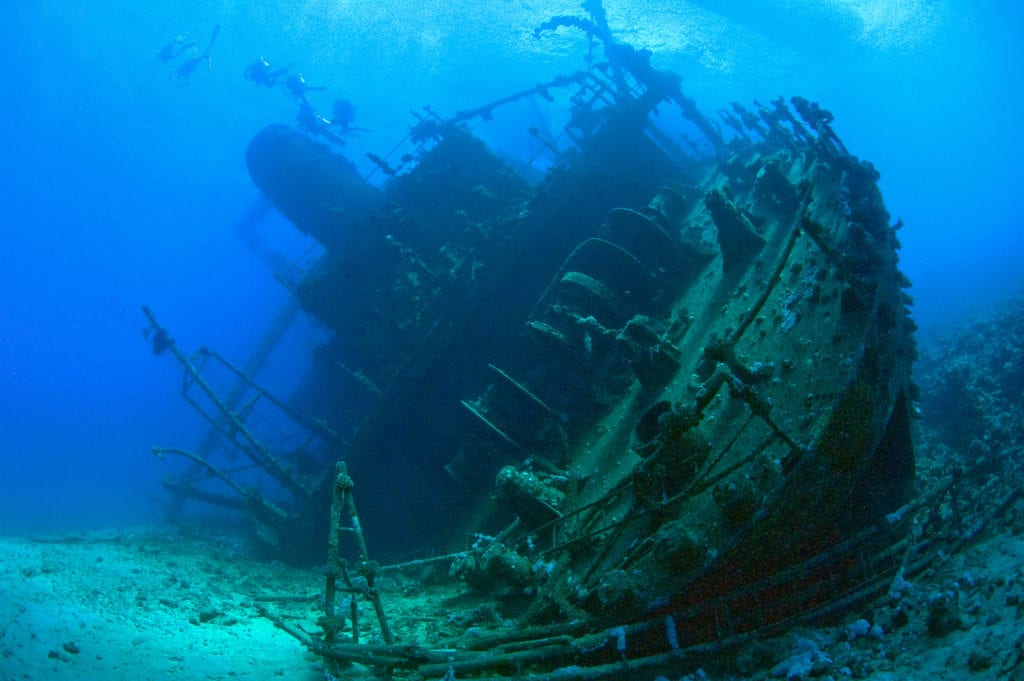
Of course, just because you’re using the right tackle and lures, doesn’t mean you can troll over any type of bottom and expect to catch tons of fish.
Some spots are better than others.
Here is where Capt. Hubbard catches most of his fish:
- Working edges of deep channels like the Tampa Bay shipping channel (he zig-zags over the edges)
- Around current seams or eddies
- Over hard bottom
- Over structure (such a wreck or reef)
- Wherever he sees a school of baitfish (note: he will often chum harder when he sees baitfish to try to get any mackerel in the area into a feeding frenzy)
Fighting Mackerel
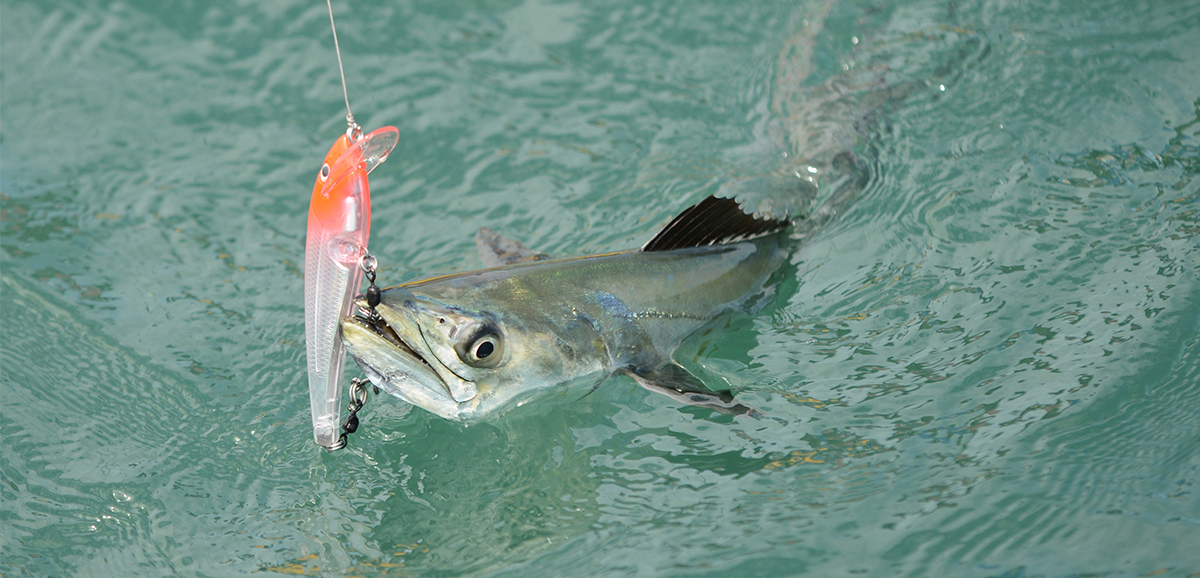
Congratulations! You’ve found the fish and got them to bite, now for the fun part.
When you get a bite, reel down until you feel the fish pull, and then when he pulls, you pull back and set the hook (unless you’re using a circle hook).
Now, there’s no need to be too aggressive, especially with braided line.
Since braided line has virtually no stretch, an exaggerated hook set is unnecessary.
After the fish is hooked, he’ll likely start peeling line off the reel.
When he does this, hold the rod up and let him run.
Often times mackerel are hooked in the head, so you don’t want to put too much pressure on them in case the hook pops off.
When you do start reeling him in, make sure that you use the rod to pull the fish towards you, and then reel down to gain line, especially if you’re using a spinning reel.
Spinning reels aren’t mean to winch the line on for you, they’re intended to take in line, so use the rod to bring in the fish and the reel to take in the line.
And here’s one final note about landing a big mackerel:
Whichever way the fish pulls, pull the other way.
This will help quickly subdue him.
Targeting Big King Mackerel
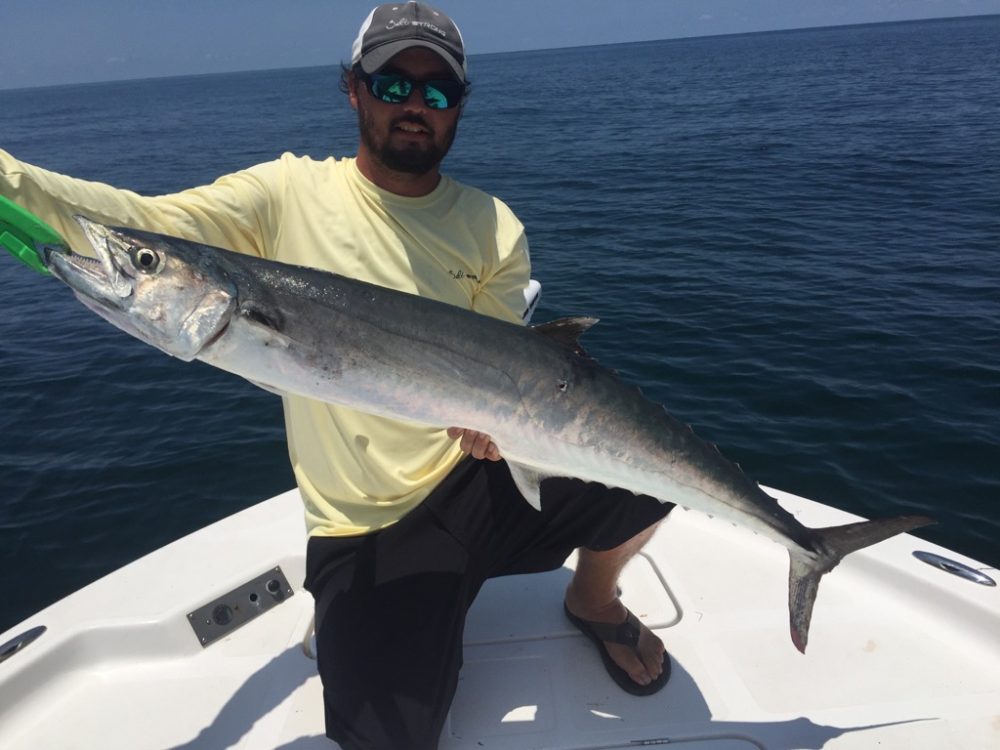
Smoker kings are the stuff dreams are made of, but if you want to bring one of these trophies to the boat, here are some things to keep in mind:
- Be patient. It could take a while to find a smoker king and entice it to bite.
- Be diligent when you’re preparing your tackle. And be especially careful when tying on your leader. A carelessly tied leader could result in heartbreak here.
- Check for knicks or abrasions every time after you reel in. The smallest knick can cause the kingfish to notice the leader and not bite, or cause the leader to break.
- The bigger the bait the more likely you are to get a big fish
- Bonus tip: if you don’t have any big baits, you can use multiple baits to make them look bigger
Alright now if you want to watch the full presentation by Capt. Van Hubbard, you can do so below.
How To Catch Spanish & King Mackerel [VIDEO]
Pretty awesome stuff right?
If you want to book a charter with Capt. Hubbard, check him out at CaptVan.com.
Conclusion
To catch more Spanish and king mackerel, follow these tips from Capt. Van Hubbard.
Slow troll and chum over structure, use the lightest leader possible, and make sure to match the hatch when using live bait or artificials.
And when you do hook into a big king, make sure to let them run and not put too much pressure on them.
Have any questions about catching more mackerel?
Let us know in the comments below!
And if you know someone who wants to catch more mackerel, TAG or SHARE this with them!
P.S. Want the best local fishing spots, discounts on fishing gear, and to stay up to date with what and where the fish are biting right now? Join us in the Insider Club!
Do You Want To Quickly Find New Fishing Spots In Your Area?
Then you’ve got to see this private fishing club!
Here’s what you’ll receive today:
- Weekly fishing reports and TRENDS revealing where the inshore fish are feeding all year long
- Weekly “spot dissection” videos that walk you through all the best spots in certain areas
- Exclusive fishing tips from the PROS you can’t find anywhere else
- Everything you need to start catching fish more consistently (regardless if you fish out of a boat, kayak, or land).
Click here to join today.
Related articles:
Related categories:
STOP WASTING TIME ON THE WATER!
Do what the “SMART ANGLERS” are doing and join the Insider Club.
Here’s what you’ll receive today when you join:
- Weekly fishing reports and TRENDS revealing exactly where you should fish every trip
- Weekly “spot dissection” videos that walk you through all the best spots in your area
- Exclusive fishing tips from the PROS you can’t find anywhere else
- Everything you need to start catching fish more consistently (regardless if you fish out of a boat, kayak, or land).










What trolling speed you recommend?
Hey Joe,
I enjoyed this post. Very complete. I also viewed the extended video by Capt. Hubbard, a very interesting, seasoned fishing expert.
What about mercury content in King Mackerel? I have heard that it was very high for Kings in the Gulf but low in Kings in the Atlantic.
Also, what about mercury content in Spanish Mackerel from the Gulf. Haven’t heard about that.
Any comments or links to further information would be appreciated.
As with any fish, the further up on the food chain they are the higher the mercury concentration is. Hence why sharks have the highest mercury concentrations. Mercury concentration in fish is only usually harmful to developing and aging brains such as fetal development, children, and the elderly. With that said, I am not a doctor and am only going off the information from the FDA. I would get the advice of your physician before eating a lot of fish with high mercury concentration like kings.